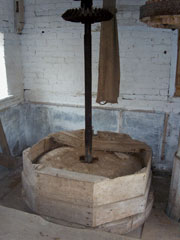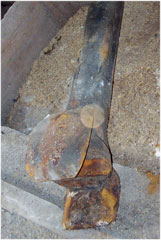Best viewed in landscape
Overhead Drive - Watermill Blog
17th March 2009
The team seemed unaware of St Patrick's great feast day and got on with things much as usual.

Colin and Richard decided to make a start on bringing the downstream pair of stones back into working order. This is the pair with the overhead drive.
This overhead drive, that enabled the stones to be driven by a portable engine of some sort outside the mill, is probably unique to Shelsley Watermill. Certainly we need to keep what we have and we would like to find the missing parts to complete the drive train.
The grain hopper and the horse that supports it were removed and carefully put to one side. Some repairs are needed but the horse,at least, is in good condition. This got us to the situation you can see in the picture above.
It was clear that the drive shaft would have to come off to allow us to inspect the stones and repair the tun. Kim and Jim joined the fun at this point and the usual lively discussion followed.
The top of the shaft was secured with rope and the top bearing unbolted. A quick wiggle made it clear to us that the shaft needed to be lifted out of the stone before it could be laid down. Colin's trusty screw jack was pressed into service and we soon had the shaft as high as it could go without fouling the beams above. Wedging the bottom of the shaft, we used to rope to gently lower the top onto the floor of the mill.

This gave us our first good look at how the drive worked; with a forked end shaped to fit over the rhynd, the gimbal mechanism that supports the runner stone.
It also revealed that the rhynd is quite different to the one supporting the upstream runner stone. This may be because this runner stone is a French burr stone or might be an adaptation to use the overhead drive.
Next we lifted off the remains of the tun. The deck has been almost totally destroyed by woodworm but some of the sides may be re-usable.
The runner stone was raised as far as the tentering screw would lift it and we gently gave it a turn. Okay so far so we dropped the stone nut into gear and pedalled the waterwheel round slowly. There are a couple of places where the cogs on the great spur gear were too tight in engagement with the stone nut but no nasty surprises.
We didn't try to turn the stone with water power as we couldn't wedge it level enough to prevent contact with the bed stone and the idea of stone hitting stone at speed when there was quite a lot of flammable material around did not appeal.
While all this fascinating work was going on inside the mill the other four members of the team got on with much less glamorous but just as essential work.
Tony prepared some ground for planting, but the plants failed to arrive so he couldn't complete the job. John did some more brickwork repairs inside the stable workshop, muttering as ever about the lack of mortar in the original brickwork.
Finton and Bob worked outside the stable but on opposite sides. Yet again they were pointing up the old brickwork using the usual lime mortar mix. At first sight this mix looks very stark but it mellows in a couple of days to something very similar to the original.
We broke up at the normal time, looking forward to various activities. In the webmaster's case this is short holiday in Spain so there will be a gap before the next blog entry. Normal service should resume on 31st March.
Go to the next Watermill Blog entry
Go to the previous entry before this overhead drive story
Learn how to Support Us
Return to our Home Page